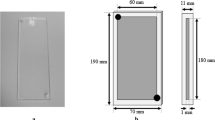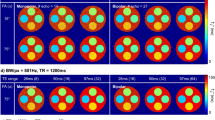Abstract
Objective
Purely exponential decay is rarely observed in conventional mono-exponential T2 mapping due to transmit field inhomogeneity and calibration errors, which collectively introduce stimulated and indirect echo pathways. Stimulated echo correction (SEC) requires an additional fit parameter for the transmit field, resulting in greater uncertainty in T2 relative to mono-exponential fitting. The aim of this study was to develop an accurate and precise method for T2 mapping using SEC.
Methods
The proposed method, called two-step SEC (tSEC), leverages spatial correlations in the transmit field to reduce the number of fully independent fitting parameters from three to two. The method involves a two-pass fit: the first pass involves a fast but standard SEC fit. The initially estimated transmit field is smoothed and provided as a fixed input to the second pass.
Results
Simulations and in vivo experiments demonstrated up to 38% and 27% decreases in relative T2 variance with tSEC relative to SEC. Average T2 values were unchanged between tSEC and SEC fits. The proposed method uses the same input data as SEC and exponential fits, so it is applicable to existing data.
Discussion
The proposed method generates reliable and reproducible quantitative T2 maps and should be considered for future relaxometry studies.





Similar content being viewed by others
References
Deoni SCL, Rutt BK, Peters TM (2003) Rapid combinedT1 and T2 mapping using gradient recalled acquisition in the steady state. Magn Reson Med 49:515–526
McKenzie CA, Chen Z, Drost DJ, Prato FS (1999) Fast acquisition of quantitative T2 maps. Magn Reson Med 41:208–212
Deoni SCL (2009) Transverse relaxation time mapping in the brain with off-resonance correction using phase-cycled steady-state free precession imaging. J Magn Reson Imaging 30:411–417
Crooijmans HJA, Scheffler K, Bieri O (2011) Finite RF pulse correction on DESPOT2. Magn Reson Med 65:858–862
Fan Z, Sheehan J, Bi X, Liu X, Carr J, Li D (2009) 3D noncontrast MR angiography of the distal lower extremities using flow-sensitive dephasing (FSD)-prepared balanced SSFP. Magn Reson Med 62:1523–1532
Syed MA, Raman SV, Simonetti OP (2015) Basic principles of cardiovascular magnetic resonance imaging: physics and imaging techniques. Springer, New York
Hoult DI, Phil D (2000) Sensitivity and power deposition in a high-field imaging experiment. J Magn Reson Imaging 12:46–67
Parker GJM, Barker GJ, Tofts PS (2001) Accurate multislice gradient echo T1 measurement in the presence of non-ideal RF pulse shape and RF field nonuniformity. Magn Reson Med 45:838–845
Collins CM, Liu W, Schreiber W, Yang QX, Smith MB (2005) Central brightening due to constructive interference with, without, and despite dielectric resonance. J Magn Reson Imaging 21:192–196
Milford D, Rosbach N, Bendszus M, Heiland S (2015) Mono-exponential fitting in T2-relaxometry: relevance of offset and first echo. PLoS ONE 10:100. https://doi.org/10.1371/journal.pone.0145255
McPhee KC, Wilman AH (2016) Transverse relaxation and flip angle mapping: evaluation of simultaneous and independent methods using multiple spin echoes. Magn Reson Med 77:2057–2065
Lebel RM, Wilman AH (2010) Transverse relaxometry with stimulated echo compensation. Magn Reson Med 64:1005–1014
Jones C, Xiang Q, Whittall K, Mackay A (2003) Calculating T2 and B1 from decay curves collected with non-180 degree refocusing pulses. In: Proceedings of 11th annual meeting ISMRM. Toronto, Canada, p 1018
Prasloski T, Mädler B, Xiang Q-S, MacKay A, Jones C (2012) Applications of stimulated echo correction to multicomponent T2 analysis. Magn Reson Med 67:1803–1814
Hennig J (1988) Multiecho imaging sequences with low refocusing flip angles. J Magn Reson 78:397–407
Weigel M (2015) Extended phase graphs: dephasing, RF pulses, and echoes—pure and simple. J Magn Reson Imaging 41:266–295
Uddin MN, Marc Lebel R, Wilman AH (2013) Transverse relaxometry with reduced echo train lengths via stimulated echo compensation. Magn Reson Med 70:1340–1346
Hui C, Esparza-Coss E, Narayana PA (2013) Improved 3D look-locker acquisition scheme and angle map filtering procedure for T1 estimation. doi: 10.1002/nbm.2969
Deichmann R (2005) Fast high-resolution T1 mapping of the human brain. doi: 10.1002/mrm.20552
Clare S, Jezzard P (2001) Rapid T1 mapping using multislice echo planar imaging. Magn Reson Med 45:630–634
Basiri R, Lebel M, Federico P (2016) Transverse relaxometry with B1+ constrained stimulated echo correction. In: Proceedings of 24th annual meeting ISMRM. Singapore, Singapore, p 1529
Cunningham CH, Pauly JM, Nayak KS (2006) Saturated double-angle method for rapidB1+ mapping. Magn Reson Med 55:1326–1333
Sacolick LI, Wiesinger F, Hancu I, Vogel MW (2010) B1 mapping by Bloch-Siegert shift. Magn Reson Med 63:1315–1322
Kumar D, Siemonsen S, Heesen C, Fiehler J, Sedlacik J (2016) Noise robust spatially regularized myelin water fraction mapping with the intrinsic B1-error correction based on the linearized version of the extended phase graph model. J Magn Reson Imaging 43:800–817
Pell GS, Briellmann RS, Waites AB, Abbott DF, Lewis DP, Jackson GD (2006) Optimized clinical T2 relaxometry with a standard CPMG sequence. J Magn Reson Imaging 23:248–252
Hwang D, Du YP (2009) Improved myelin water quantification using spatially regularized non-negative least squares algorithm. J Magn Reson Imaging 30:203–208
Smith HE, Mosher TJ, Dardzinski BJ, Collins BG, Collins CM, Yang QX, Schmithorst VJ, Smith MB (2001) Spatial variation in cartilage T2 of the knee. J Magn Reson Imaging 14:50–55
Raj A, Pandya S, Shen X, LoCastro E, Nguyen TD, Gauthier SA (2014) Multi-compartment T2 relaxometry using a spatially constrained multi-Gaussian model. PLoS ONE 10:100. https://doi.org/10.1371/journal.pone.0098391
Saekho S, Boada FE, Noll DC, Stenger VA (2005) Small tip angle three-dimensional tailored radiofrequency slab-select pulse for reduced B1 inhomogeneity at 3 T. Magn Reson Med 53:479–484
Lee CE, Baker EH, Thomasson DM (2006) Normal regional T1 and T2 relaxation times of the brain at 3T. In: Proceedings of 14th annual meeting ISMRM. Seattle, USA, p 959
Alecci M, Collins CM, Smith MB, Jezzard P (2001) Radio frequency magnetic field mapping of a 3 Tesla birdcage coil: experimental and theoretical dependence on sample properties. Magn Reson Med 46:379–385
Wang J, Mao W, Qiu M, Smith MB, Constable RT (2006) Factors influencing flip angle mapping in MRI: RF pulse shape, slice-select gradients, off-resonance excitation, and B0 inhomogeneities. Magn Reson Med 56:463–468
Alecci M, Collins CM, Smith MB, Jezzard P (2000) BI field plots for a 3 tesla birdcage coil: concordance of experimental and theoretical results. In: Proceedings of 8th Annual Meeting ISMRM. Colorado, USA, p 1391
Jones CK, Whittall KP, MacKay AL (2003) Robust myelin water quantification: averaging vs. spatial filtering. Magn Reson Med 50:206–209
Whittall KP, MacKay AL, Li DKB (1999) Are mono-exponential fits to a few echoes sufficient to determine T2 relaxation for in vivo human brain? Magn Reson Med 41:1255–1257
Deoni SCL (2010) Quantitative relaxometry of the brain. Top Magn Reson Imaging 21:101–113
Nöth U, Shrestha M, Schüre J-R, Deichmann R (2017) Quantitative in vivo T2 mapping using fast spin echo techniques—a linear correction procedure. Neuroimage 157:476–485
Author information
Authors and Affiliations
Contributions
RB: study conception and design, acquisition of data, analysis and interpretation of data, drafting of manuscript, and critical revision. PF: study conception and design, and critical revision. RML: study conception and design, acquisition of data, analysis and interpretation of data, and critical revision.
Corresponding author
Ethics declarations
Conflict of interest
Dr. Lebel is an employee of GE Healthcare. The remaining authors have no conflicts of interest or financial ties.
Ethical approval
All procedures performed in studies involving human participants were in accordance with the ethical standards of the institutional and/or national research committee and with the 1964 Helsinki declaration and its later amendments or comparable ethical standards.
Additional information
Publisher's Note
Springer Nature remains neutral with regard to jurisdictional claims in published maps and institutional affiliations.
Rights and permissions
About this article
Cite this article
Basiri, R., Federico, P. & Lebel, R.M. Transverse relaxometry with transmit field-constrained stimulated echo compensation. Magn Reson Mater Phy 32, 669–677 (2019). https://doi.org/10.1007/s10334-019-00769-9
Received:
Revised:
Accepted:
Published:
Issue Date:
DOI: https://doi.org/10.1007/s10334-019-00769-9




